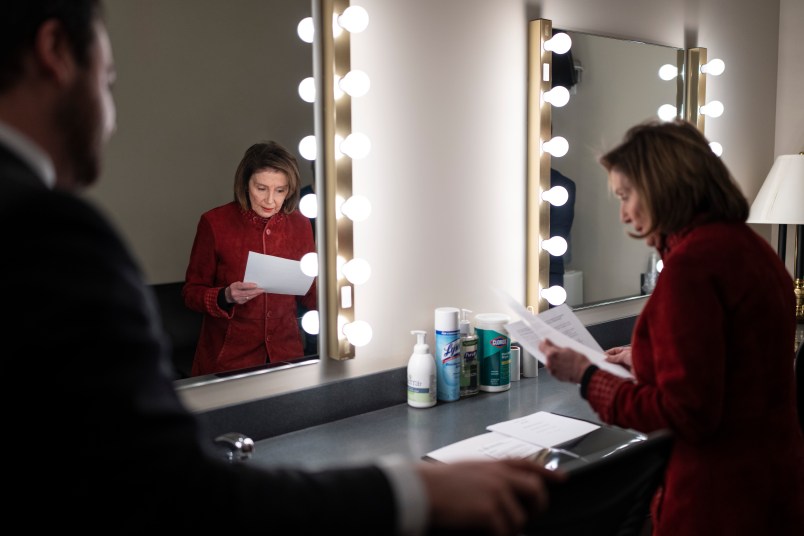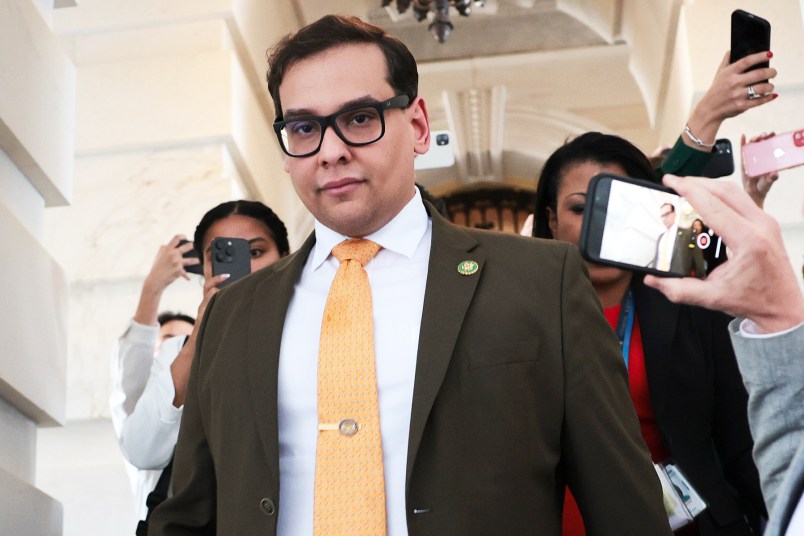The video of the brutal attack on Paul Pelosi released last week brought a story back into the headlines that, somehow, had faded just days after David DePape broke into the home of the third most powerful person in the country, intending to hurt or kill her.
Within days of the video being released, the story has slipped from the national conversation again.
Mona Lena Krook, an associate professor who specializes in women and politics at Rutgers University, told TPM that she’d been asked to write about the attack at the time, but that the news outlet changed its mind a couple days later.
“Sorry, it’s really busy and the story’s out of the news cycle,” she recalled an editor saying. “It’ll happen again, unfortunately.”
While Paul Pelosi still recovers from a hammer blow to the skull along with other wounds from last October — Nancy Pelosi said in a recent interview that she expects it to take a few more months for her husband to be back to normal — we still haven’t sufficiently reckoned with the drumbeat of misogyny at the heart of the attack, and in the reactions to it.
“Any woman in political life is breaking gender expectations,” Krook said. “Those with power are even more threatening to the status quo — and Pelosi has broken so many barriers.”
She’s been featured to a disproportionate degree in Republican attack ads from the moment she became House Minority Leader in 2003. As she climbed the ladder to Speaker — often the only woman in a pack of male congressional leaders — the right grew comfortable casting her as the poster child for the Democratic Party’s ills.
But the criticism extended far beyond opposition to her policy positions, and those held by the party she helped lead. The hatred hurled at Pelosi has always been intensely misogynistic. In recent years, with the burgeoning of social media, the creation of a circuit connecting those online communities with far-right TV, radio and podcasts and the permission granted by Donald Trump to dehumanize his political opponents, the vitriol has only intensified.
The Cost Of Being A Woman In Politics
Speaker Kevin McCarthy (R-CA) has joked about hitting Pelosi with the Speaker’s gavel; Rep. Marjorie Taylor Greene (R-GA) indicated support for executing her; several January 6 insurrectionists said that they were going to the Capitol specifically to hunt and murder Pelosi. She’s a constant boogeyman on Fox News, complete with unflatteringly edited photos, and her online treatment is only cruder and more violent.
The Republican Party has been using her face in campaigning against Democrats since 2003, before she was widely recognizable. Before the 2010 midterm elections, the National Republican Congressional Committee was using Pelosi in 70 percent of its ads, easily eclipsing those mentioning then-President Barack Obama. The trend continued, with her being invoked in TV ads seven times as often as her then-Senate counterpart Harry Reid (D-NV) in 2012 and around three times as often in 2014 and 2016, according to the Wesleyan Media Project.
“People can’t stand to see a woman in that position of power, and to do as good a job as Nancy Pelosi did,” Nina Jankowicz, vice president at the Centre for Information Resilience, told TPM. “And she’s a woman past her reproductive prime, which the right hates — as well as certain parts of the left — since women are only good for making babies. She hits a lot of different pain points for them.”
Jankowicz has firsthand experience being the “main character” in the right’s dark hatred fantasies.
After she was tapped to lead the Department of Homeland Security’s Disinformation Governance Board last spring, she was deluged with online disinformation campaigns leading to threats of the caliber and quantity that she resigned the post.
Now, nearly a year later, the venom continues to flow. She told TPM that she recently had to take protective measures against one of the online harassers, and that Jim Jordan (R-OH), newly named chair of the House Judiciary Committee, has been sending letters, posted to his Twitter, to try to get her to come testify.
“I can still tell when I’m mentioned on Fox News,” she said. “The amount of vitriol in my mentions, inbox etc. is unsurpassed.”
That some contingent of the right sees Pelosi as not only a political opponent but someone fundamentally evil and dangerous is not a Pelosi-specific dynamic. Research shows that female politicians are treated very differently from male ones, the sexism bleeding through in everything from the women’s seemingly impossible quest to win the coveted “likeability” tag to being inundated with death threats. The abuse is often even worse for female politicians of color.
“When people criticize men in positions of power, they say ‘your policies are stupid,’” Krook said. “For women, it’s ‘you stupid, fat bitch, you’re so ugly, just kill yourself and die.’”
“People say, ‘oh, politics is dirty for all people.’ Men are not threatened with rape,” added Kristina Wilfore, co-founder of #ShePersisted, an organization focused on combating gender abuse and disinformation online.
This misogyny, which permeates how even non-bad faith actors talk about Pelosi, can be seen in the reaction to the attack on her husband too. Republicans are no longer even held to the bare minimum of denouncing it: Virginia Governor Glenn Youngkin (R) joked about it at a campaign stop hours after it happened; RNC chair Ronna McDaniel used it to take a swing at Democrats’ position on crime.
And, as is the way of the right-wing media circuit, others offered much darker responses. Fox News host Tucker Carlson mused that DePape was actually Paul Pelosi’s lover; Elon Musk shared with his nearly 128 million followers a link to a conspiracy site alleging that Paul Pelosi was hosting a sex worker in an episode that turned violent; Rep. Claudia Tenney (R-NY) tweeted (then deleted) “LOL” in response to a photoshopped picture of men with hammers next to a gay pride flag.
The release of the video of the attack did nothing to correct those believing some flavor of this completely baseless conspiracy theory. Right-wing accounts online could be found stubbornly picking out details of the video to “corroborate” the fantasy.
“They are so hardwired to hate her and to believe she can’t possibly be in a loving marriage that her husband must be gay,” Jankowicz said.
Online Threats To Offline Attacks
The danger in this bubbling vat of hatred, stirred and maintained by Republican politicians, Fox News hosts, alt-right podcasters and social media users alike, is how accessible and far-reaching it is online.
For some, posting is enough: Telling a female politician to go kill herself on Twitter will scratch that itch. But inevitably, those communities will include unstable, violent people, willing to not just make death threats but to carry them out.
“There’s a very increasingly short pathway between what was political rhetoric and is now offline action,” Wilfore said. “Because if you believe what they’re saying, then my gosh, China is coming around the corner to brainwash your kids, school boards are grooming your kids to be gay, women politicians are making your house vulnerable to being broken into.”
But such a system can only be sustained by the power of indifference: indifference by social media companies to enforce the community standards they have or to put new ones in place, indifference by the politicians who see this language as politically beneficial, indifference by law enforcement befuddled by how to deal with anonymous harassers often living states or countries away, indifference by a citizenry that largely hitches up its shoulders and shrugs at this, the cost of being a woman in public.
It all drives in the same direction: to push women out of politics, or to make sure they never enter in the first place. Pelosi, then-third in the line of succession, had a constant security detail — and her husband might have died if he hadn’t had the wherewithal to call 9-1-1. Who’s protecting the women who run for secretary of state or the state House or the school board? Why would women willingly take on those roles if it means threats to their safety, their bodies, their homes, their families?
A study of Congressional candidates during the 2020 campaign found that “women were far more likely than men to be abused on Twitter” and, on Facebook, that Democratic women received 10 times more abusive comments than their male counterparts. On both platforms, the researchers found that the abuse towards men more often related to their policy stances, while abuse towards women was often “based on their physical appearance and perceived lack of competence.”
“The sexist attacks on women’s competency, the innuendo about their character, serve a larger anti-democratic goal,” Wilfore said. “It’s hiding the fact that these campaigns are designed to discredit and devalue women politicians, with the goal of forcing them out of political life and undermining the democratic system.”



